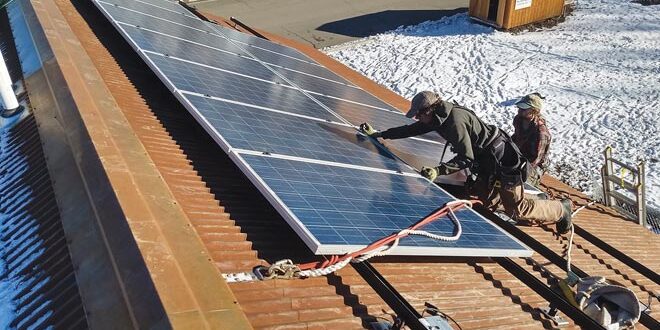“Healthy housing benefits us all”
[ By Kendra Walker ]
Habitat for Humanity Gunnison Valley (HHGV) aims to provide affordable housing opportunities to community members in need, and this year added an additional element to its mission: With each home build, to bring a positive impact to the local community, economy and environment. This new direction is reflected in the organization’s first energy-efficient home build, located on South 6th Street in Gunnison.
“We are increasing our goals as an organization to not only serve low income families with affordable housing but to do it in such a way that it has the greatest positive impact on our local community, economy and environment,” said HHGV executive director Julianne Robinson. “We are very fortunate to have such passionate and hardworking homeowners in Ed Morrison and Ellie Fortune to be the first recipients of this vision, enabling us to have a proving ground. Our board, donors and professional construction partners have also been incredibly supportive of this project and it has been wonderful to see such interest and excitement from this community.”
Robinson shared that this new approach connects health and housing. “Healthy housing benefits us all, it benefits our environment. We’re really trying to make an impact on how we build, not only by impacting the lives of the people we’re serving, but we also want to impact the community with how we build, and how we teach people to build. If we can inspire five more people to build better, then we’re making an impact.”
The all-electric, straw bale home on South 6th Street was designed to be as affordable, healthy and resilient as possible with low running costs and maintenance. Part of the reasoning behind trying to make the space so energy efficient, Robinson explained, is because of the expense of utilities in the Gunnison Valley, especially for those in need of affordable housing. “So much energy leaves Gunnison County, with our cold climate and old housing stocks. Those utilities can really drive up the cost of housing for people in the middle of the winter. It just seems crazy to budget that when you’re on a fixed income. The cost of heating your home should ultimately be affordable too.”
Going solar
The house was set up so that it could accept solar in the future, but when it was built last year, HHGV didn’t have the budget to add solar.
Luckily, a Crested Butte homeowner was upgrading her solar system and generously donated her old panels to the HHGV home. “Her panels were still good, they still have life in them,” said Robinson. “We’re really excited that this donation came through.”
PV installers at Nunatak Alternative Energy Solutions also donated their time to help, and recently finished installing the solar panels that will produce enough energy to completely power the home and all its systems year-round.
“The solar system is sized to completely offset all of the electric usage in the home on an annual basis,” said Lena Wilensky of Nunatak Alternative Energy Solutions. All the systems in the house are electrically powered, allowing for solar and alternative energy, so the homeowners can reduce their carbon footprint while also saving money. An installed solar array will soon produce more energy than it uses. “This will make the home Net-Positive, even providing income to the homeowners,” said Robinson.
Additionally, the system will have a surplus of energy that will be used to completely power the construction of HHGV’s next home build in 2021, as well as have the capacity to charge an electric vehicle in the coming years at no cost.
Locally sourced and environmentally friendly
HHGV also aimed to use as much local labor materials as possible with this home, to both lower environmental costs and provide stimulus to the local economy.
“We estimate around $30K to $40K was spent on local materials during this build compared to a conventional build, while not increasing the cost to the homeowner,” said Robinson. “As an organization whose intention is to serve low income families, we are very proud to be able to retain the equivalent of an average annual salary in the local economy.”
The building’s envelope is composed of a hybrid of local lumber, straw bales and cellulose insulation, with clay and lime plaster finishes. “These materials also happen to be affordable, locally available and very low in health risks,” said Robinson. Another material that was utilized on this build was sheep’s wool, used to replace spray foam around the windows and doors.
 The Crested Butte News Serving the Gunnison Valley since 1999
The Crested Butte News Serving the Gunnison Valley since 1999



